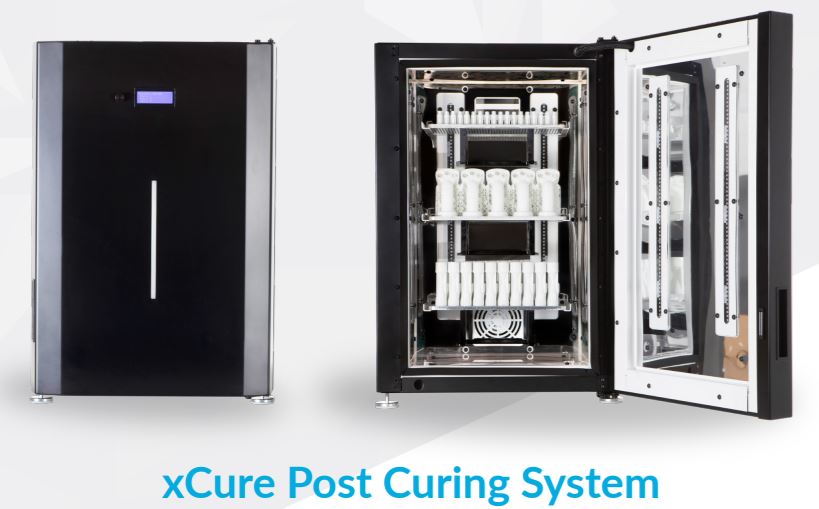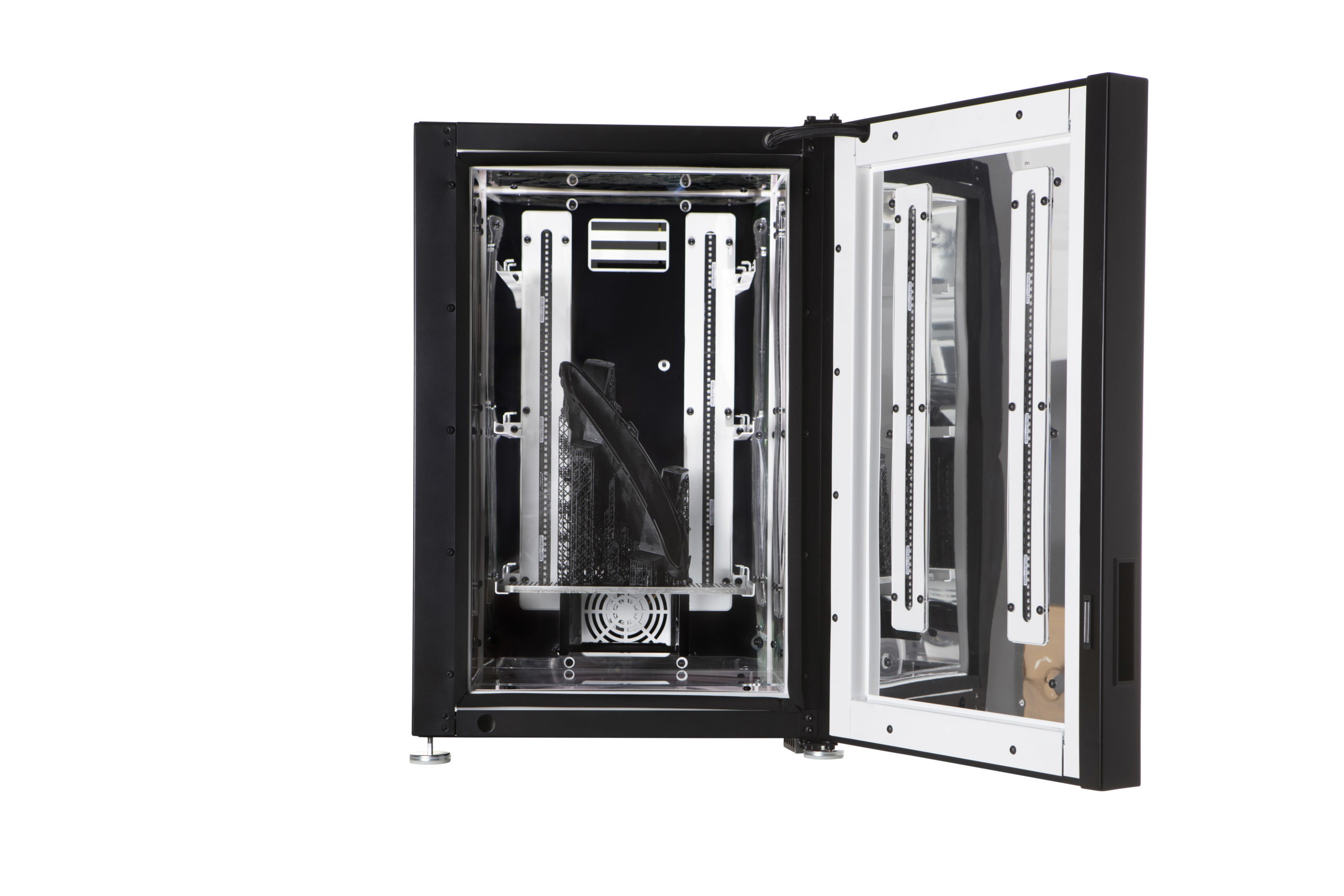Nexa3D, known for its high-speed polymer additive manufacturing (AM) production systems (liquid resin and powder-based) has announced the launch of a post-processing solution, xCure, for photopolymer parts. The company had indicated in April this year that it would release its automated washing and curing systems in the summer. Following up on hardware from its NXT Factory subsidiary, this is the most recent hardware introduction the company has made this year.
The curing system is designed specifically for the company’s flagship high-speed digital light processing (DLP) 3D printer, NXE400. It can cure three NXE400 build plates simultaneously, or a single part up to 16 liters in volume, using simple, single click-rotate and push-button functionality. Interestingly, the washing station automates the length of wash by detecting part volume. Similarly, the curing station automates light intensity and distribution of its 365+405 nanometer LEDs by detecting the geometry and positioning of the parts on the build plate.
The system aims to provide optimal curing through three operational modes—UV only, Heat only, and UV+Heat—and has a heating capacity between 30°-60°C with 1°C increments. It offers predictive and prescriptive capabilities for material-specific curing, resin-specific pre-sets for all NXE400 materials, and 360° of light and thermal coverage. Highlighting how tailored the system is to optimizing post-processing for each part or material, the company states:
“xCure’s Perfect Part Optimization process consists of dual wavelength LEDs, multi-build plates, and parallel UV and thermal processing. xCure’s validated end to end workflows drive the perfect balance of temperature, UV wavelength, and material-specific sequences to deliver the perfect cure. These optimal and effective curing cycles guarantee consistent mechanical properties and predictable part performance. The net result is, less post-processing time, faster time to market, better part performance, increased 3D printing productivity and of course – the perfect part.”
The launch of xCure follows several new product announcements, including xClean, an eco-friendly washing solvent that can be used with resin-based 3D printers, and new materials xCE-Black and xCE-White, the fastest single cure material in the company’s portfolio. The xCure post-processing system can also be used with recently launched ABS and other biocompatible materials developed in collaboration with Henkel.
“We are very excited to bring xCure to market, underscoring our commitment to deliver fully validated workflow solutions for manufacturing at scale,” said Avi Reichental, Co-founder and CEO, Nexa3D. “Our work with key manufacturing companies and leading material suppliers reveals that only through the rigorous development, simulation and testing of predictive and prescriptive end-to-end workflows can we unlock the full range and consistency of mechanical performance.”
In June this year, early into the pandemic, Nexa3D continued to expand its network of partnerships beyond North America by announcing reseller agreements in five countries: Belgium, Netherlands, Poland, Portugal and South Africa. Later in August this year, the company acquired NXT Factory with its pioneering quantum laser sintering (QLS) systems, which immediately expanded its addressable market to over $10 billion. With high-speed production SLS, Nexa3D now offers highly complementary polymer additive manufacturing solutions distinct for their speed in production. Its Lubricant Sublayer Photo curing (LPSc), with a self-lubricating membrane, can produce up to 16 litres at 1Z centimeter a minute, making over 100 functional electric harness strain relief sleeves in under 10 minutes. The QLS system, launched by NXT in 2019, prints at 4X the speed of current sintering systems, with a print speed of 4200 cubic centimetres per hour.
Following this, the company partnered with Siemens to integrate and standardize its newly acquired QLS machines into the conglomerates’ Industry 4.0 digital factory platform. The two companies had already worked together in serving automotive, aerospace, medical and industrial customers, and beginning in early 2021, will look to combine factory automation technologies, IoT connectivity, digital twin sensing and more, with Nexa3D’s additive manufacturing solutions. Kuba Graczyk, Head of Nexa3D’s Thermoplastics Additive Business saw this as the right time for such collaboration in additive manufacturing, saying,
“We believe that this collaboration is essential given the strengths of the 3D printing industry as demonstrated throughout the Covid-19 pandemic, and this is the right time to realize the combined potential that this partnership unlocks for the benefit of our expanding customer base.”
In September, Nexa3D also partnered with DSM to add into the QLS-350’s material portfolio DSM’s supply-chain approved laser sintering material, Arnite T AM1210 (P) beginning 2021, which is aimed specifically at additive solutions for series production in industrial and automotive electronics.
Subscribe to Our Email Newsletter
Stay up-to-date on all the latest news from the 3D printing industry and receive information and offers from third party vendors.
Print Services
Upload your 3D Models and get them printed quickly and efficiently.
You May Also Like
Making Space: Stratasys Global Director of Aerospace & Defense Conrad Smith Discusses the Space Supply Chain Council
Of all the many verticals that have been significant additive manufacturing (AM) adopters, few have been more deeply influenced by the incorporation of AM into their workflows than the space...
EOS in India: AM’s Rising Star
EOS is doubling down on India. With a growing base of aerospace startups, new government policies, and a massive engineering workforce, India is quickly becoming one of the most important...
PostProcess CEO on Why the “Dirty Little Secret” of 3D Printing Can’t Be Ignored Anymore
If you’ve ever peeked behind the scenes of a 3D printing lab, you might have caught a glimpse of the post-processing room; maybe it’s messy, maybe hidden behind a mysterious...
Stratasys & Automation Intelligence Open North American Tooling Center in Flint
Stratasys has opened the North American Stratasys Tooling Center (NASTC) in Flint, Michigan, together with automation integrator and software firm Automation Intelligence. Stratasys wants the new center to help reduce...





































